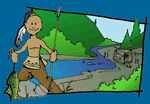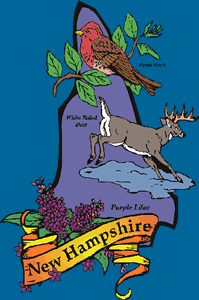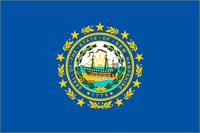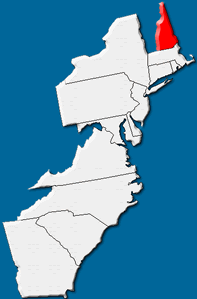


Geography and Landforms:
New Hampshire is sometimes referred to as the "Mother of Rivers." Five of the great streams of New England originate in its granite hills. The Connecticut River rises in the northern part. The Pemigewasset River starts in the Profile Lake in the Franconia mountains and joins the Winnipesaukee at Franklin to form the Merrimack. The Cocheco and Salmon Falls rivers join at Dover to form the Piscataqua. In addition, two of the principal rivers of Maine, the Androscoggin and the Saco, begin in northern New Hampshire. |
 History:
English King James I gave the land that now includes Maine and New Hampshire to Ferdinando Gorges and John Mason in 1622. The two men divided the land in 1629, Mason receiving his share between the Merrimack and Piscataqua rivers. He named it after his home county in England, Hampshire. Mason, in conjunction with several others, sent David Thomson, a Scotsman, and Edward and Thomas Hilton, fish-merchants of London, with a number of other people in two divisions to establish a fishing colony in what is now New Hampshire, at the mouth of the Piscataqua River. |
 Economy:
Manufacturing has been important in New Hampshire since the late 1800s. The textile mills and factories producing leather goods (such as shoes and boots) that once lined the state's fast-moving rivers have given way to high-technology firms. Lumbering has been important since the first sawmill was built on the Salmon Falls River in 1631. Most of the timber cut now is used in paper production. Although New Hampshire has long been known as the Granite State, its large deposits of the stone--used for building as early as 1623--are no longer extensively quarried because the use of steel and concrete in modern construction has greatly decreased the granite market. |
 First Inhabitants:
Archaeologists believe the first humans came to the area now known as New Hampshire around 10,000 years ago after the glaciers receded and the climate warmed. These tribes became more settled and less nomadic as time went on. Because of climate and length of growing season, tribes in the north of New Hampshire probably engaged in more hunting while tribes in the south engaged in relatively more agriculture, although agriculture probably never had the importance in early New Hampshire that it had further south in what we now call Massachusetts.
|
Books Related To New HampshireThe Bear That Heard Crying - Natalie Kinsey-Warnock Dillon Dillon - Kate Banks The Enormous Egg - Oliver Butterworth First Boy - Gary Schmidt G is for Granite: A New Hampshire Alphabet - Marie Harris Lucy's Summer - Donald Hall Night Wings - Joseph Bruchac Stained - Jennifer Richard Jacobson The Trouble with Jeremy Chance - George Harrar A Week in the Woods - Andrew Clements |
Famous Citizens:
|
| Capital: | Concord |
| Entered Union: | June 21, 1788 |
| Population: | 1,326,813 |
| Area | 9,350 |
| Bird | Purple Finch |
| Flower | Purple Lilac |
| Nickname: | The Granite State |
| Governor | Maggie Hassan |
Places to Visit in New Hampshire: (Click the links to learn more.)
|



